B2B Email Marketing Tactics: 11 Ways to Crush Your Competition
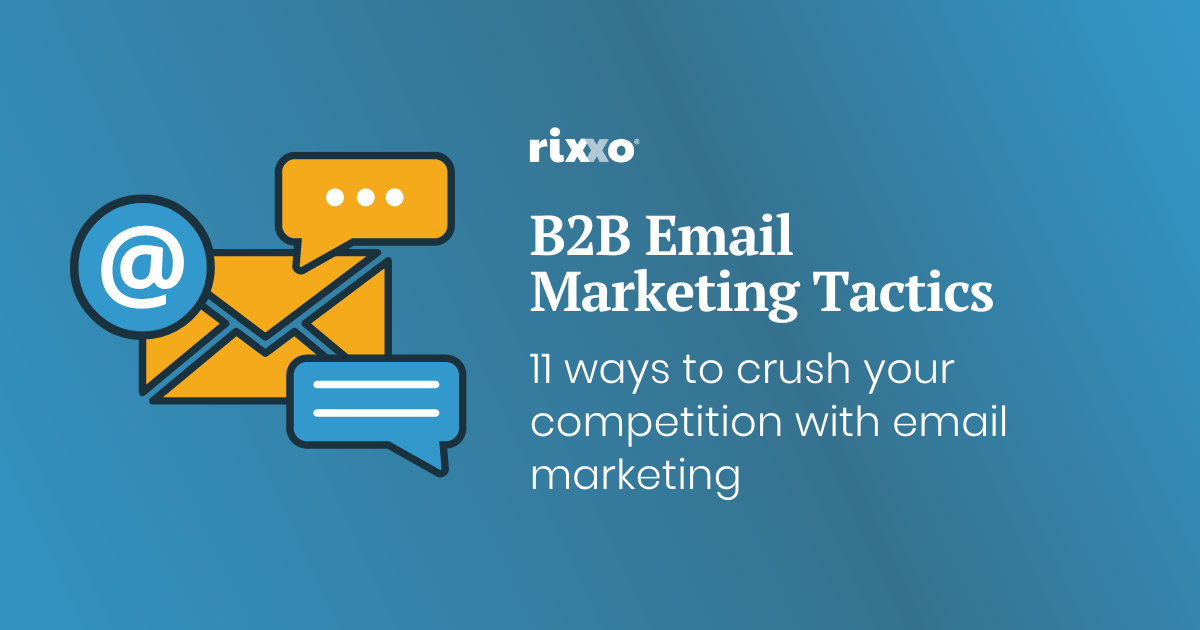

What is B2B email marketing?
Successful B2B email marketing is all about building trust, creating emotive content, and tempting users into action. It can be used to nurture relationships, build brand awareness, and generate sales. Successful B2B email marketing campaigns are tailored to the needs and interests of your target audience, while providing valuable information that encourages them to take action.
In today’s crowded inbox, it’s more important than ever to stand out from the competition. That means your email marketing efforts should be relevant, informative, and engaging. It also means using a variety of tactics to capture attention and drive results.
B2B sales cycles are longer: Here’s why
In our post, B2B websites, how they are different, and how to make them successful we discussed how B2B (business-to-business) sales cycles are typically longer than B2C (business-to-consumer) sales cycles for a number of reasons.
- Decision-making process: In B2B sales, there are often multiple decision-makers involved in the buying process. This can add time to the sales cycle as each decision-maker must be consulted and their input considered.
- The complexity of the products or services: B2B products and services are often more complex than B2C products and services. This can require more time for a B2B audience to understand the benefits of the product or service and to make a decision.
- Budgets: B2B customers typically have larger budgets than B2C customers. This can add time to the sales cycle as the customer may need to go through a purchasing process before making a purchase.
- Risk: B2B customers are often more risk-averse than B2C customers. This can add time to the sales cycle as the customer may want to do more research and due diligence before making a purchase.
As a result of these factors, B2B sales cycles can be anywhere from 3 to 12 months or even longer.
The value of an email list
A B2B email marketing strategy is likely to deliver the highest return on investment (ROI) of any marketing communications channel. Campaign Monitor reported B2C email marketing generates $44 for every $1 spent. That’s an astounding 44x ROI.
We need to make the most of our opportunities to reach our B2B customers with timely messages. In this article, we’ll look at the various ways to run a B2B email campaign and offer examples of how to traverse the B2C / B2B subset and could be used, especially for those in the B2B eCommerce space.
In today’s digital age, businesses need to make the most of every opportunity to reach their customers. Effective B2B Email marketing is one of the best ways to do this.
Think human, not business and let go of the idea of B2B and B2C.
When you’re communicating with prospective customers, remember that you’re not talking to a company, you’re talking to a person. So, instead of using jargon and buzzwords, speak to them in plain language. Tell them how your product or service can help them solve a problem or achieve a goal. And most importantly, be genuine and authentic. People can spot a fake a mile away, so just be yourself.
When you take this approach, you’ll build relationships with your customers that will last for years to come.
Here are some specific tips for communicating with potential customers in a human-to-human way:
- Use their name. Addressing someone by name shows that you’re paying attention and that you value them as an individual.
- Ask questions. People are more likely to open up to you if you seem interested in what they have to say.
- Be empathetic. Try to see things from their perspective and understand their needs.
- Be positive and enthusiastic. People are more likely to be receptive to your message if you’re upbeat and positive.
- Be yourself. People can spot a fake a mile away, so just be yourself and let your personality shine through.
By following these tips, you can build relationships with your customers that will last for years to come.
1. Welcome emails
First impressions last a lifetime. This will often be your first communication with a new customer or subscriber and it’s important to set the tone. CRM Sales and Marketing platform Hubspot states that welcome emails receive around 50% open rate – 86% higher than newsletters!
Welcome emails receive around 50% open rate
MARKETINGSHERPA
Firstly, it is important to offer a “thank you”, after all, manners don’t cost a thing. It is polite and starts to set a tone for your future communications. Customers will also be expecting to see branding that matches that of the source they have come from i.e. your website or micro experience.
The main image of your email should create “a moment of delight” whilst the rest of the email should be packed full of information and links to help a user improve their experience with your brand. This could include loyalty programs, social media links, email settings, and the latest offers.
Welcome email example: Charles Tyrwhitt
This is a great welcome email for a clothing retailer.
The design perfectly matches the website, the hero image is quintessentially British like the brand and catches the eye.
The content of the email marketing reinforces the brand messages and is packed full of useful links to encourage you to engage with the email regardless of your stage in the buyer cycle.


2. Promotional emails
We’ve onboarded our new customer or subscriber now it’s time to start enticing them to make purchases. Promo emails tend to be the email marketing that get the most attention from marketers, but they are also being sent by the billions around the world, so let’s look at some best practices to make yours stand out.
First up, frequency. Each business will have a feel for the frequency they should be sending, but the optimum according to Campaign Monitor once a week is best. It’s ok to be persistent, but you don’t want to become a pest. When you have something you need to say, or a seasonal opportunity like Black Friday comes about, then it is okay to send additional emails. Adding relevant twists to your designs, like snow at Christmas can freshen up the look and make the mail more engaging but let’s not go over the top or back to 2001.
To make the best promo emails, we suggest some key ingredients;
Catchy subject lines – this needs to stand out in an inbox and drive the user to open yours from a sea of other emails. Using emojis can be effective. Read more about what makes a great subject line on the Phrasee website
Don’t forget the preview – most email clients will show users a line or two of text, make sure this supports the subject line and doesn’t just contain some default text like “open in a web browser”
Detail, detail detail – if you are including a discount or offer, make sure the details are very clear. You increase your chance of losing loyalty if your customer finds a catch after spending. Be clear!
Make it emotive – when designing your email marketing, make sure you use imagery you know appeals to the emotions of the customer which will drive engagements. Use powerful words and interactive content to tempt a user to click through.
Perfectly personalise – use personalisation in both subject lines and content to make a user feel recognised and show that you understand who they are and what they want.
Make it a series – if you have a big promo upcoming, then consider making it part of an email marketing series. Use a teaser, or number of them, to build excitement and to prime your users for an upcoming prom. Maybe they’ll skip buying something elsewhere in preparation to part with some cash in your store.
Promo email example: Bose


This example from Bose for its Black Friday sales is beautifully designed with emotive images and words whilst being simple and clear to understand.
When a user clicks through, a discount is already applied and displayed on their website removing any friction from the checkout process.
3. Order confirmations
Order confirmation emails are one of the most opened types of emails. Users want to know they’ve purchased the right product, they’ve been charged the right price, and most importantly, when they’ll receive it.
Order confirmation emails have a 70% open rate.
Hubspot
Importantly, order confirmation emails should be sent immediately. It should also give your customer the option to change items or order more. Order confirmation emails are also a great place to upsell or cross-sell items, or even for adding a referral offer to save them money off their next order.
Order confirmation email example: Chewy.com
Here are the key elements for an order confirmation:
- Order reference number
- Shipping address
- List of ordered products
- Photos of ordered items
- Prices of each item
- Savings made (if applicable)
- Delivery cost/method
- Total of order
- Delivery date
- Delivery method
- Delivery tracking ref (or state this will be sent separately)
- Contact information
- Loyalty points info – how many points earned or how many points a user could have earned with instructions on how to join)


4. Shipping notifications
Once again, your user will look out for these emails and be more inclined to open them. We are all interested to know when our latest purchase will arrive, especially if you want or need it urgently. The same principle as order confirmation emails applies; take the opportunity to promote something, but make sure the important elements are all present.
Shipping notification email example: Apple
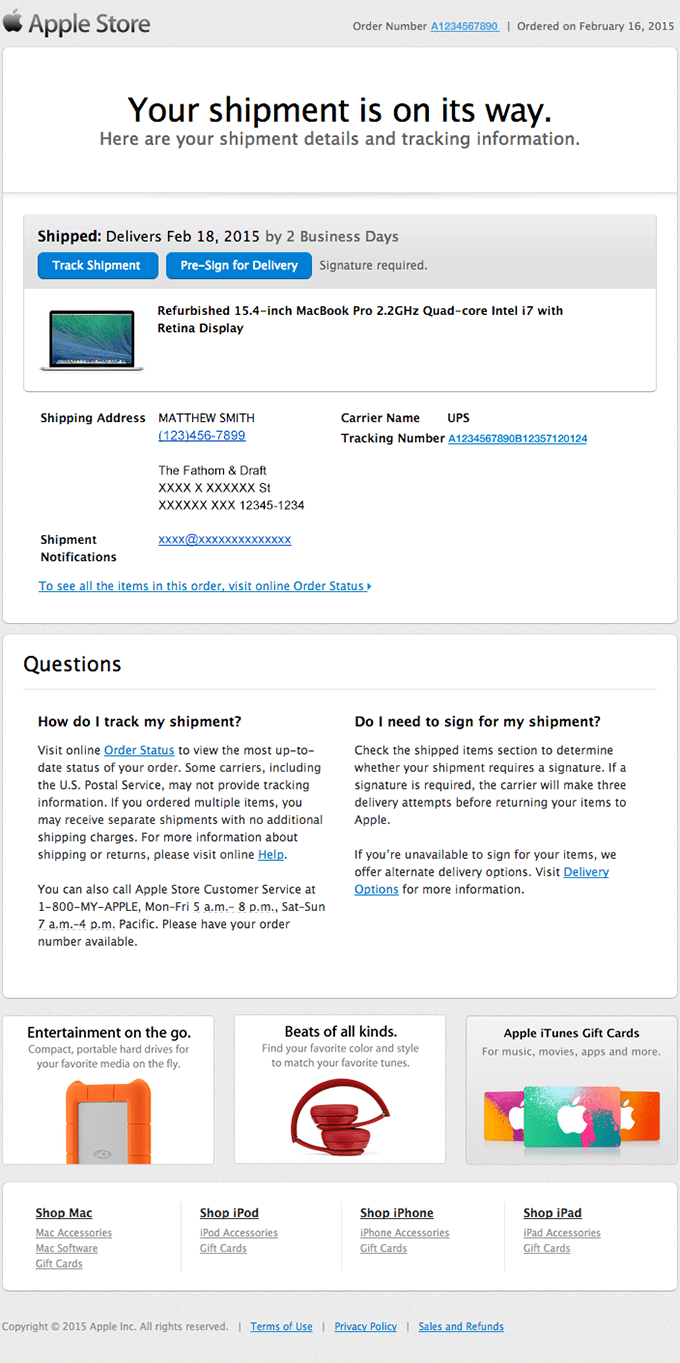

A few tips to make sure your shipping notifications are well received;
- Make sure the email marketing template is on-brand
- Repeat the order information as before
- Inform the customer about shipping details
- Provide a tracking number and instructions on how to use
- Link users to delivery FAQs
- Make sure contact details can be found easily
- Highlight the process for returns or damages
- Say thank you
5. Abandoned cart emails
Cart abandonment email marketing is one of the most important B2B eCommerce marketing weapons in your arsenal. On average 67% of all carts are abandoned, so giving yourself an extra chance to land that sale is very important.
B2B and B2C regulations on data and data usage are different. And so is the customer journey. You are more likely to find a need to login to a website on a B2B website, especially to see custom pricing and credit facilities. With this in mind, you know who the user is when they are putting items into their basket, and your privacy policy and subscriptions have hopefully been set up to allow you to remind customers they forgot to complete their purchase.
We need to be aware that a user has abandoned their cart for a reason, so we need to be sensitive and tactful in our approach.
Abandoned cart email marketing example: Adidas
Here are some tops tips for getting them back to your store and finishing the purchase:
- Links should navigate back to their carts with products and discounts all present
- Discounts should be applied
- Send short sequences, not just a single email
- Personalise the emails
- Write clear and compelling subject lines
- Include pictures
- Make it easy to opt-out of further Cart Abandonment emails (we don’t want them to block you totally!)
- Ask for a reason – why did they leave? Follow up appropriately based on their response


6. Notifications
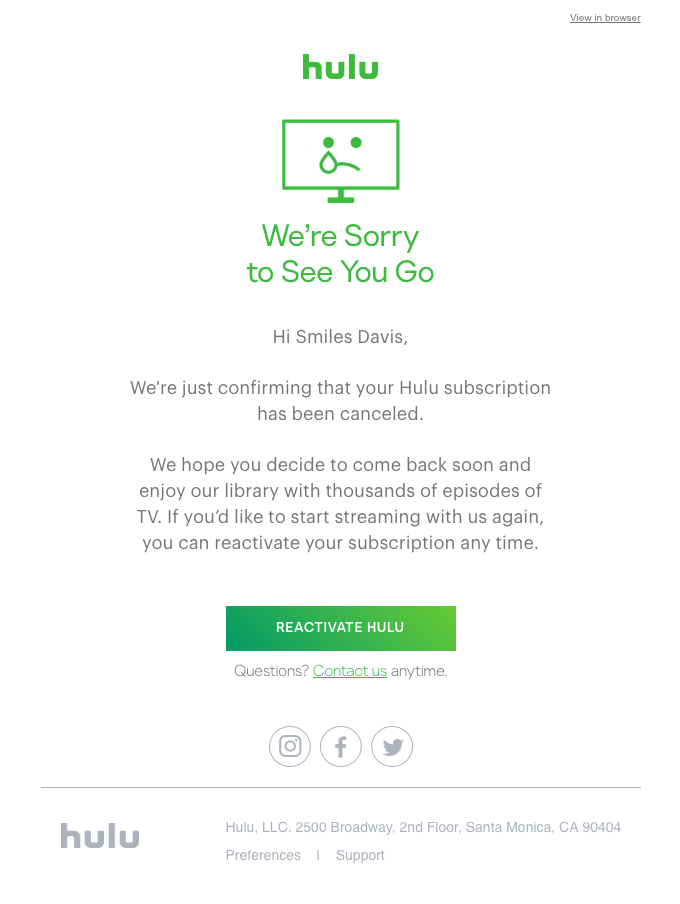

Notifications are short and focused emails to let people know what is going on. These are often not given much attention as they are seen as dull. They are used to let people know that changes are made to their email address, settings, frequency, etc.
These messages actually receive some of the best open rates here our tips for success:
- Ensure subject lines are clear and to the point
- Personalise the greeting
- Keep content to the point and include just one message at a time
- Make sure these emails are sent immediately
- Include only one call to action (CTA)
- Make sure they are branded in line with your other email marketing and website
- Hi [FNAME], Change the default text!!
7. Reactivation emails
Hubspot research suggests that the average email list degrades by around 22.5% every year. We can use several tactics to try and reactivate an email, many of which happen outside of email itself, but when you are keeping it simple, you can try:
- Appealing to the humorous side
- Tell clients what has changed or what they are missing
- Offer an alternative like Facebook Messenger
- Show them advance preference settings so they only get what they want
- Try something fun, rewarding and exciting like our Mobile Scratchcard Instant Win tool
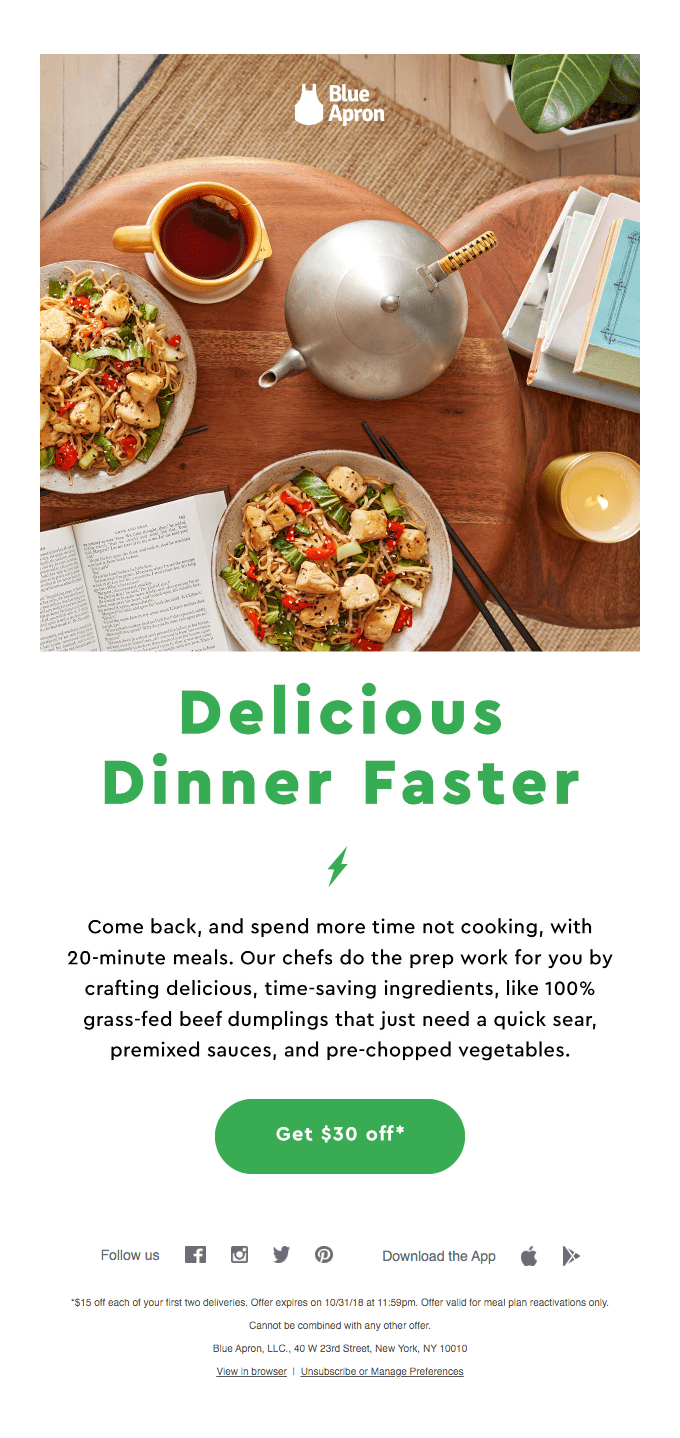

8. Apology email
Research suggests that it is 6-7 times more expensive to win a new client as it is to keep a current one. Having an email ready to go just in case something goes wrong is essential for these times. It may be a mistake you have made on a large scale like a technical issue or getting something wrong in your newsletter. Perhaps it’s a one-to-one issue like a missing item or late delivery. Either way, being prepared with an email for these situations will allow you to react quickly and reassure your customers.
Apology email example: Fab
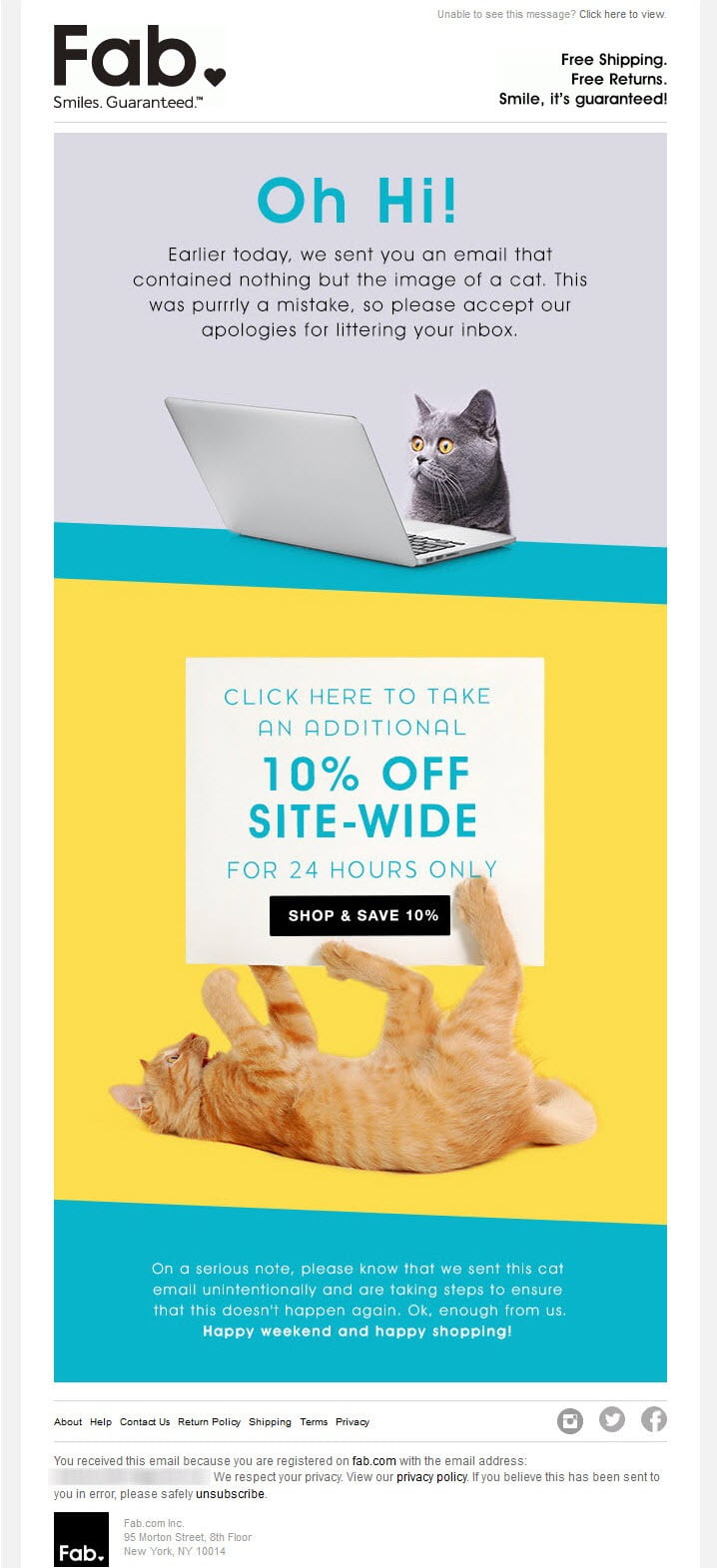

It is critical the content, tone, and imagery are suitable for the situation, but some useful rules to follow are:
- React quickly
- Make the design clear and concise
- Make sure the email is perfectly on-brand
- Be honest and polite
- Only use humour if your brand is good at it (and the situation isn’t too grave);
(Wrong price or link in an email marketing newsletter?? Yeah – let’s make light of it! But, if a large scale data breach strikes… please don’t joke.)
9. Surveys via email


Surveys are hugely important to gain feedback from your audience. Even if your users are like the other 75-85% of people who do not respond, they’ll be reassured you are listening and are giving your tribe a voice.
We love to use Google Survey Forms or SurveyMonkey as they are quick to build and have a simple UX. Some principles apply regardless of your approach
Incentivise – If the data that you will gather is valuable to you offer a reward for completing your survey. You’ll likely see twice the response rate. If the data gathered is valuable to the user share the results with them as the incentive to answer.
Keep surveys short – keeping them short and sweet is always best. Offer a follow-on survey if you have lots of information to gather. (We love giving the customers a “one-click option” like the email below)
Share the outcomes – if people feel like they are part of our business, you will forge stronger relationships and create brand advocates
10. Dynamic content emails
Dynamic content email marketing uses automation tools to populate and personalise the content based on sets of predetermined rules. This means you can personalise mailings at scale.
This is a more complex email marketing tactic and relies on a CRM system and a good set of data.
We like Hubspot, DotMailer, SendinBlue, and Mailchimp. If you have a custom CRM or CMS you may need an integration built directly between them to ensure high-quality data.
Some common types of dynamic emails you should consider:
- Best selling products
- Recently added products
- Recently viewed or suggestions based on website activity
- Most viewed / most popular
- Biggest savings
We increased conversion by 300%
Would you like to see how we used some of these techniques to increase the success of Travelzoo marketing campaigns?
11. The thoughtful email
Lastly, think about how you can go the extra mile. Online gadget and gift retailer Firebox sends out quick emails to their customer base before they start seasonal emails. It is a great example of being sensitive to your audience’s needs. They show great compassion asking if people would like to opt-out of Mothers/Fathers Day promo emails. This kind of activity will help keep people subscribed to other emails and build brand loyalty. Kudos to them.
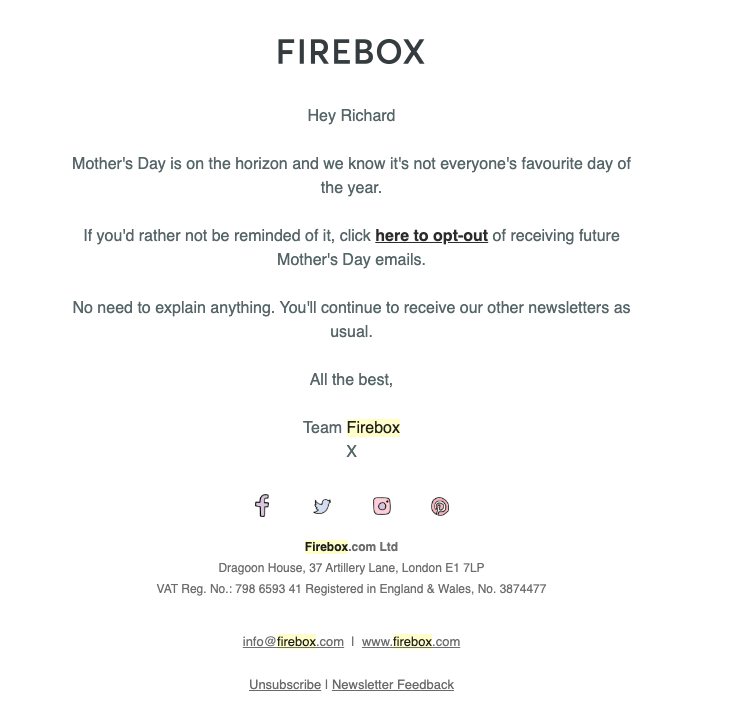

Conclusion
The most important email marketing you need is transactional emails – they are opened more and are expected. However, the most important emails to think about are your promotional emails. We live in a busy world and you’ll need to work hard to get attention.
B2B email campaigns need to cut through the noise. Inboxes are full of marketing emails, so it’s important to make yours stand out.
If you are not sending out the basic list of emails regularly then this could be a quick win. Our biggest tip though is to personalise the content and automate as much as possible!
